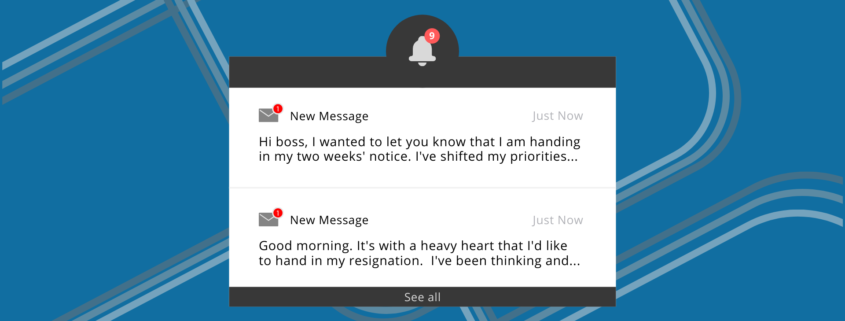8 Strategies to get ahead of the Great Resignation
By now, you’ve probably heard of the Great Resignation. Around the world, millions of people are quitting their jobs and pursuing new opportunities, informed by lessons learned since the start of the pandemic. For most of 2020, anyone who still had a job (even those who’d been thinking about leaving it) decided to “sit tight”. The worst of the uncertainty cemented most employees in place, anxious to see what the future would hold. But as the pandemic wore on, new trends appeared, and now the global workforce is shifting significantly.
The global workforce is reshuffling
For many, the pandemic prompted a shift in focus. Billions of people were forced to reflect on their lives, their careers, their wellbeing, and how these three major facets of their lives interact. Values, priorities, and personal goals came to the fore, and millions realised that their roles didn’t quite fit in as well as they’d thought.
Now that some geographical areas are enjoying more stability, staff feel “safe” enough to move on and find opportunities that align with their values. And so, we see a massive amount of people resigning and reshuffling within the global workforce. According to Microsoft’s 2021 Work Trend Index, a whopping 46% of the global workforce is considering a job change.
Many countries are already in the midst of the massive shift. Of course, this isn’t true for all locales. Your organisation might still be fighting to find its feet amidst ongoing lockdowns and restrictions in flux. Whether you are struggling to retain your team, or you’ve already lost key team members to the global reshuffle, here are our best insights to help you engage your team and grow your business sustainably:
8 Strategies to get ahead of the Great Resignation
They’re not workers, they’re humans
Your team members are not a means to an end, nor should they feel like it. It is your duty as the employer to maintain a psychologically safe workplace, and that means that you should respect mental health, empower a work-life balance, and provide flexibility where it’s needed most. Particularly if your organisation is based in an “unstable” COVID environment, it’s important that your team members feel like they are valuable, rather than just a cog in the machine. It’s the latter that drives people to resign and look for more meaningful work.
Speaking of which:
Renegotiate roles and responsibilities
This is a great move for organisations that aren’t empowered to recruit new staff right now. Retaining your team is of utmost importance right now. Check in with your team members and investigate what makes them tick. Ask your team member which tasks energise them and which drain them. Where possible, shift projects around so that your team is able to spend more time on what excites them. This goes a long way to reframe how they think about work and its place in their lives. Minimising the energy their role drains from them reduces the risk of burnout and resignation.
Improve your internal processes
If you’re not empowered to grow your organisation right now, it’s a prime opportunity to review your internal processes and work out the kinks. Find and treat the pain points that your teams put up with. Let go of legacy systems that bottleneck your workflow so that your team can do great work more easily, reliably, and accessibly. Projects like these reduce frustration and improve productivity, scalability, and future-readiness.
If you are fortunate enough to be in a more “stable” COVID environment, enjoying greater mobility and proximity to “normal life”, there are still some strategies you should consider to retain and hire great talent:
Appeal to values
Whilst it’s important to advertise salary when recruiting new team members, you have to step up your game to appeal to candidates these days. Most people have reevaluated their values, and how their job and lifestyle contribute to or work against them. Your organisation must articulate benefits that go deeper than just money. Think about what people value: their health, their loved ones, their sense of wellbeing, growth, recognition. Articulate how you celebrate these values, and great candidates will come. For example, do you offer health insurance, generous parental leave, lots of learning and development, internal mobility, a strong culture of reward and recognition?
Recruit Australia-wide
If the role can be done remotely, consider recruiting from all across Australia and New Zealand and driving economic growth for all. Drawing from a wider talent pool makes it easier to find a great new team member in a competitive candidate market. The flexibility that a remote role offers is also incredibly attractive to some people and could set you apart from the competition.
Consider “downsized” candidates
Since the start of the pandemic, multitudes of talented people “downsized” their careers to reduce the amount of pressure and responsibility in their work lives. As is their right! Your organisation would do well to consider candidates whose resumes differ from your “usual suspects” and embrace these experienced professionals who are content to take on more “relaxed” roles. The hesitation usually stems from a worry that highly qualified or experienced candidates apply for roles that are “beneath” them because they’re looking for a quick, easy fix between bigger roles. This is not necessarily true, anymore. The candidates cover letter will show you what they’re after, so be discerning, and address this concern directly in your interviews. You never know, their knowledge could still be a valuable resource in a “downsized” role.
Consider upskilling
Where labour shortages are considerably high, consider upskilling and reskilling your current team to fill skills gaps. A whopping 94% of employees say that they would stay at a company longer if their learning and development is invested in, according to this LinkedIn Learning Report. And organisations are starting to understand this, with upskilling and reskilling reported as a top priority for L&D professionals globally. It’s easy to see how developing your current team benefits your organisation: improving internal mobility, engaging team members, retaining talent, and improving adaptability.
Recruit smarter
If your current environment empowers you to hire new team members, consider your internal resources. If your HR team is strapped for time and resources, consider a recruitment partner to find and hire great team members who fit the bill. A recruitment partner can reach further, advertise more effectively, and power through the administrative tasks that you simply don’t have the capacity to. Focus on uplifting your team while your recruitment partner bridges the gap between where you are now and the growth you want to achieve.
Regardless of your current position, these strategies help you to improve your culture and look after your current team. Whether you’re hiring right now, or couldn’t fathom it, helping your team do their best work and feel valuable to your organisation goes a long way towards retaining talent, until such time as you recruit more.













